|
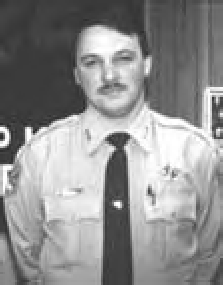
|
Michael Dee Pace - Deputy Sheriff
Bryan County Sheriff’s Office December 29, 1998
On Wednesday, December 23, 1998, Deputy Sheriff Michael Pace was south bound on Highway 69/75 on his way home at about 1:45 a.m. his thoughts most likely on spending Christmas with his family. Deputy Sheriff Pace’s Bryan County Ford cruiser was now approaching Choctaw Road as it had many times before. There was some glare in the mist from the headlights of the north bound traffic. Suddenly a dark east bound flatbed tractor trailer appeared across the south bound inside and part of the outside lanes of the highway. The young deputy sheriff reacted by turning his Ford cruiser to the right, but Deputy Sheriff Pace was unable to avoid the portion of the flatbed trailer behind the last set of dual wheels. The impact sheered the hood and top from the deputy’s cruiser. The lower portion of the cruiser continued southwesterly into a ditch and caught fire. The semi-truck and flatbed trailer pulled on east to clear the intersection. Witnesses put out the fire with a fire extinguisher and tended to Deputy Sheriff Michael Pace until the ambulance arrived.
Deputy Sheriff Michael Pace was transported to the emergency room of the Durant hospital and later transferred to the Wilson N. Jones Hospital in Sherman, Texas, arriving there at 8:20 a.m. Deputy Pace had sustained massive head trauma and lived almost a week as family and friends kept an around the clock vigil at his bedside. Deputy Sheriff Michael Pace never regained consciousness. Deputy Sheriff Michael Pace died on Tuesday, December 29, 1998, just before 8 a.m.
Deputy Sheriff Michael Pace was survived by his wife Shanna and their young son and daughter, Austen, and Haley.
Michael Pace is buried in Colbert Garden of Memory Cemetery, Colbert, Bryan County, Oklahoma.
OLEM – 4S-2-2 NLEOM – 10E21
Updated December 4, 2024
|
|
|
|
|
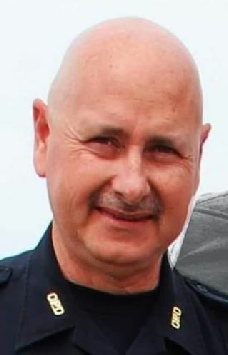
|
Edgar “Buddy” Pales, Jr. - Senior Patrol Officer
Owasso Police Department August 29, 2021
Edgar “Buddy” Pales, Jr. was born September 10, 1966, in Tulsa, Oklahoma to Edgar Pales, Sr. and Frankie Ray (Brust) Pales. Buddy Pales was raised in Owasso, Oklahoma, and began his law enforcement career as a dispatcher for the Owasso Police Department in July 1992.
Edgar “Buddy” Pales was sworn in as an Owasso Police Officer in January 1995. Buddy eventually became a canine officer with his long-time friend K-9 Britt. After Britt’s retirement Buddy was partners with K-9 Shadow. Later Buddy became a School Resource Officer along with his long-time friend Officer John Edwards. Many years of students in the Owasso school system knew Buddy Pales and John Edwards as the “school cops.” Buddy Pales several years later returned to the streets as Senior Patrol Officer for the B-1 Patrol Shift for the remainder of his twenty-eight-year career with the Owasso Police Department.
In late August, Edgar “Buddy” Pales was hospitalized with the Covid-19 virus which he had contracted during the course of his patrol duties. Edgar “Buddy’ Pales, 54, died Sunday afternoon, August 29, 2021, from complications from the Covid-19 virus.
Edgar Buddy Pales was survived by his daughter Kasey Pirrone, her husband Kyle and their young sons Alex and Leo Pirrone. Buddy was also survived by his parents.
Edgar “Buddy” Pales’ earthly remains were cremated.
OLEM – 10N-3-18 NLEOM – 51E32
Updated August 29, 2023
|
|
|
|
|
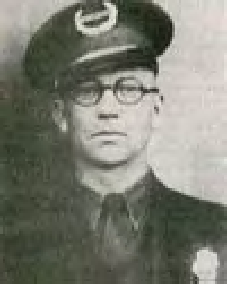
|
Cal Urmson Palmer -Patrolman
Enid Police Department July 8, 1936
Shortly before midnight on Wednesday, July 8, 1936, Patrolmen Cal Palmer, 37, and Ralph W. Knarr answered a call at The German Village, a popular tavern in Enid.
Jim Neill, proprietor of the tavern, had called police stating, “There’s a ‘bad’ man in my place, and I think there’s going to be a hold-up.” Jim Neill noticed the hard-looking, slight built stranger as he sipped a beer watching both front and side doors of the tavern as if he were expecting someone. Jim Neill thought he had recognized the man from pictures he had seen in the newspapers. Harry Grubbs, an employee, mentioned the similar circumstances preceding the Plaza Grill robbery at Oklahoma City.
The two Enid patrolmen casually entered the front door of the tavern. The officers approached the stranger and asked him to step outside with them. The man stated he thought he knew why they were there and asked if he could finish his beer. Being told he could, the man removed a cigar from his mouth and lifted the mug of beer with his left hand. At the same instant, he dropped his right hand beneath the table and started shooting with a .38 caliber pistol he was holding in his lap. Officer Cal Palmer died instantly with three bullets in his chest. Officer Ralph Knarr fell next with bullets through his right shoulder and neck, in the right side and abdomen. Another bullet struck a customer standing fifteen feet away. The killer then dashed out the side door. The stranger, escaped convict Lawrence DeVol, fled down the alley to a nearby service station where he was shot and killed by other officers as he attempted to car jack two men.
Patrolman Cal Palmer was buried on July 10, 1936, in Memorial Park Cemetery, Enid, Garfield County, Oklahoma and was survived by his wife and two young sons.
Enid Officer Ralph Knarr survived his wounds.
OLEM – 7N-1-24 NLEOM – 46E3
Updated July 7, 2024
|
|
|
|
|
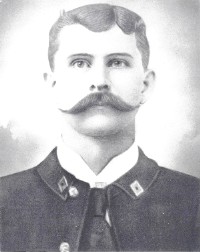
|
David Thomas "Bud" Palmer - Deputy Sheriff / Constable
Seminole County Sheriff’s Office / Punkin Center January 8, 1929
David Thomas “Buddy” Palmer was born in February 21, 1870, the seventh of thirteen children born to William Asbury and Alta L. (Barnes) Palmer in Lamar County, Alabama. David Palmer moved with his wife Saretha Jane (Stanford) and five children from Lamar County, Alabama to Seminole County, Oklahoma in 1916, at the age of 46. David Palmer soon became a Deputy Sheriff for Seminole County and was the Constable for the township Punkin Center. Deputy Palmer’s wife Saretha died June 6, 1917, two months after their sixth child Denman was born.
On Tuesday, January 8, 1929, at about 11 a.m., Deputy Sheriff David Palmer, now almost 59 years old, was sent to search for three men who had robbed several oil workers near Maud. Deputy Sheriff Palmer located the three men about 1:30 p.m. on a road one mile south of Bowleg. Deputy Palmer drew his gun and ordered the men to put up their hands. Two of the men complied but the third man opened fire on Deputy Palmer with a .22 caliber, nine shot revolver. Deputy Palmer returned fire before he fell mortally wounded with three gunshots to his neck.
Deputy Sheriff David Palmer was survived by his six children Jesse, William, Allen, Tollie, Alpha, and Denman.
David Palmer is buried in Oakwood Cemetery, Wewoka, Seminole County, Oklahoma.
All three of the robbers were later arrested. Prentice Reed, the one who shot Deputy Sheriff David Palmer, was sentenced to life in prison.
OLEM – 4S-3-5 NLEOM – 31W23
Updated January 6, 2024
|
|
|
|
|
|
Joseph Palmer – Special Agent
Missouri, Kansas, and Texas Railroad
On Tuesday, November 28, 1922, the Missouri, Kansas, and Texas Railroad (MK&T) depot at Agra in northern Lincoln County was robbed by a lone black male. Three MK&T special agents from Oklahoma City were sent to investigate the robbery. The next day, on November 29th the three agents boarded a train in Lincoln County headed for Kansas City. The three agents were Joe Palmer, who had formerly been an Oklahoma City Police Officer for twenty-two years, Ben Moore, a former deputy sheriff and C. M. England. The agents had observed a black male fitting the description of the loan armed robber board the train a few stations from Agra. The three agents approached the black male, George Gray, and began to search his suitcase, Gray drew a gun and shot agent Joseph Palmer in the hand and leg. The other agents then shot Gray several times.
Both Special Agent Joseph Palmer and George Gray survived their wounds. George Gray was charged with the armed robbery of the Argo MK&T depot.
Some earlier newspaper articles had reported that Special Agent Joseph Palmer died of his wounds.
OLEM – 1N-3-3
Updated September 24, 2024
|
|
|
|
|
|
Slack "Nappy" Palmer - Deputy Sheriff
Pawnee County Sheriff’s Office December 10, 1911
Deputy Sheriff Shack Palmer was shot Friday night December 8, 1911, at Fisher, three miles west of Sand Springs, in a gun fight with another black man he was trying to arrest for shooting two men at Ripley the previous Wednesday.
Deputy Sheriff Shack Palmer died in a Tulsa hospital at 4 a.m. Sunday, December 10, 1911, following surgery.
The suspect was turned up by black citizens of Beggs on Monday with three bullets in his body and was turned over to Sheriff William McCullough.
Deputy Sheriff Shack Palmer is buried in Oaklawn Cemetery, Tulsa, Tulsa County, Oklahoma.
OLEM – 4N-1-14 (Slack Palmer) NLEOM – 13W31
Updated December 7, 2023
|
|
|
|
|
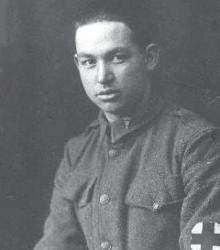
|
William "Louis" Pappan - Prohibition Agent
Internal Revenue Service
U.S. Treasury Department December 4, 1935
William L. Pappan, Sr. was born November 24, 1894, at Kaw City, Kay County, Oklahoma to Henry and Lucy Janeta (Matney) Pappan. By 1919 William Pappan had been married once and had two children. In 1919 William Pappan married Grace Octavia Maxwell. Three children were born to this union.
After serving in the Army, William Pappan became an Agent with the Internal Revenue Service. William Pappan had been an IRS agent for ten years when just before midnight on Wednesday, December 4, 1935, he and private investigator George Stewart went to the Sheridan Club at 51st and Sheridan Road in Tulsa to check for liquor sales.
Agent Louis Pappan was talking to J.L. Birkhead, a former county highway patrolman who was operating the spotlight for a floor show in progress, when George L. “Hickory” McCullough and Tyree Parks approached him from the club’s kitchen area. A fight broke out between the three men and investigator George Stewart. The struggle continued outside the club and several shots were heard.
Witnesses found both Agent Louis Pappan and investigator George Stewart dead. Both men had been beaten severely about the head. Private Investigator George Stewart had been shot twice in the left side with bullets that penetrated his body from side to side, and once in the head.
Agent Louis Pappan had been shot five times in the back of the head in addition to a fractured skull from the blows to his head. Four guns were found lying around the bodies.
George McCullough and Tyree Parks were both arrested and charged with the murders, both men having long histories with Tulsa County law enforcement.
Louis Pappan’s obituary noted that he was a first cousin of Charles Curtis, the former Vice-President of the United States under President Herbert Hoover.
Agent Louis Pappan was survived by his second wife Grace and five children, Robert Henry, 20, Marian Rose, 19, William Louis, Jr, 12, Carolyn Sue, 10, and Stephen Maxfield, 6.
William L. Pappan, Sr. is buried at Memorial Park Cemetery, Tulsa, Tulsa County, Oklahoma.
Agent Louis Pappan’s great-grandson, Billy D. Walkabout, would become the most decorated Native American of the Viet Nam War.
OLEM – 8S-4-18 NLEOM – 52E27
Updated December 3, 2023
|
|
|
|
|
|
James Eli Parish - City Marshal
City of Bennington July23, 1912
On Tuesday, July 23, 1912, City Marshal James Parish, 33, was given a judgment to serve on Sam Buford, a local rancher who had been sued in civil court. City Marshal James Parish was to confiscate Sam Buford’s cattle. That morning, City Marshal Parish confiscated the cattle and headed back to Bennington when he was confronted by Sam Buford’s two sons, Newt, and Iman. City Marshal James Parish was shot in the chest with a shotgun and in the head with a Winchester rifle which killed him. City Marshal Parish was able to shoot Iman Buford in the right chest during the gunfight before he died.
City Marshal James Parish was buried in the Bennington Cemetery, Bennington, Bryan County, Oklahoma and was survived by his wife Effie and five young children.
Iman and Newt Buford were tried twice for the murder of City Marshal James Parish. The first trial ended in a hung jury, but they were both acquitted in the second trial.
OLEM – 4N-1-10 NLEOM – 5W30
Updated July 22, 2024
|
|
|
|
|
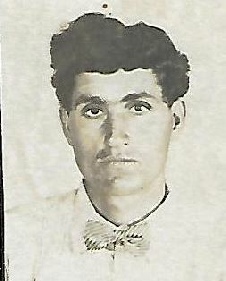
|
John Daniel Parker - City Marshal
City of Krebs December 31, 1933
John D. Parker was born September 7, 1892, at Bokoshe, in what would become Le Flore County, Oklahoma to Benjamin Franklin and Ann Elizabeth (Broyles) Parker..
Early the morning of Sunday, December 31, 1933, City Marshal John Parker, 41, was making his rounds accompanied by his nephew Lee Parker, whom he had deputized. City Marshal Parker went into the place of Clifton Logan, a local bootlegger. Finding Jack Winningham drunk, City Marshal Parker arrested him. Jack Winningham resisted, and City Marshal Parker struck him in the head with his pistol. The city marshal then took Jack Winningham to a local doctor’s office to have him treated for his injuries.
While at the doctor’s office, Clifton Logan arrived, furious that the city marshal had arrested Jack Winningham in his place. The two argued, Clifton Logan drew his gun, and City Marshal Parker began struggling with him. Witnesses said Lee Parker fired at Clifton Logan and accidentally hit his uncle, City Marshal John Parker as well as Clifton Logan. City Marshal John Parker died from his wounds. Clifton Logan was critically injured and died the next Saturday. The county attorney’s office indicated that no charges would be filed against young Lee Parker.
John Parker had been the City Marshal for a year and a half and was survived by his wife Ester Ann (Perkins) and their five children.
John Parker is buried in Oakhill Memorial Park Cemetery, McAlester, Pittsburg County, Oklahoma.
OLEM – 1N-1-5 NLEOM –
Updated December 30, 2023
|
|
|
|
|
|
Marcus F. Parker – Deputy U.S. Marshal
U. S. Marshal Service
(Died in Kansas)
Deputy Marshal Marcus Parker along with Deputy Marshal Joseph Vannoy of the Western District of Arkansas and their two pose F. M. Watkins and G. M. Carpenter traveling in a spring wagon had spent most of the day, Friday, March 21, 1873, following the trail of four horse thieves in northern Indian Territory.
Deputies Parker and Vannoy knew the men they were tracking had come from Missouri and were traveling east to west. As the officers followed the tracks of the horse thieves, the tracks would leave the Indian Territory and cross into Kansas then re-enter the territory. Just west of the Osage Nation the officers noticed that the thieves had turned north. Since it was getting dark the officers camped for the night. Just after daybreak the next morning, Saturday, March 22, 1873, the deputies spotted their prey still camped at Hilton’s Crossing on Grouse Creek just inside Kansas south of Silverdale. Soon the deputy marshals pulled their spring wagon up to the thieves’ camp and started getting down off the wagon. The deputies ordered the men to throw up their hands. Their order was answered with gunfire with the deputies returning fire in a pitched gun battle. Deputy Marshal Marcus Parker, who had been fighting with one of the men over a shotgun, was shot by another thief, later identified as John Stroup. Deputy Marshal Joseph Vannoy was able to wound John Stroup in the shoulder before the other three horse thieves escaped into surrounding area. Deputy Marshal Vannoy did not give pursuit, but along with their posse tried to give aid to Deputy Marshal Joseph Vannoy but he died within fifteen minutes.
John Stroup was taken to a nearby house, the home of a Mr. Gilstrap, and placed under guard and a doctor sent for to treat his wound. Several days after the shooting, a mob forcibly took John Stroup and lynched him for killing Deputy Marshal Parker.
Deputy Marshal Marcus Parker’s body was taken to Elgin, Kansas where he was buried. The funeral procession was led by Parker’s Masonic friends. The exact location of Deputy Marshal Marcus Parker’s burial is unknown.
A continuing investigation found that the other three horse thieves were Tom Davis, John Tussey and James Stewart. Deputy Marshal Joseph Vannoy worked with Deputy Marshal S. S. Peterson of the District of Kansas in tracking the remaining three thieves. In early June, the two deputies traveled to Watsego, Illinois where they arrested James Stewart and returned him to Emporia, Kansas to await trial in Cowley County. James Stewart was tried the first week of August and found guilty of manslaughter and sentenced to three years in prison.
The other two horse thieves, Tom Davis and John Tussey were never located.
OLEM – 4N-2-11 NLEOM –
July 7, 2021
|
|
|
|
|
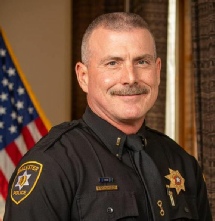
|
Richard Shawn Parker – Captain
McAlester Police Department March 16, 2023
Richard S. Parker was born May 28, 1970, in McAlester, Oklahoma to Ricky J. and Linda (Newman) Parker. Richard Parker grew up in Wetumka, Oklahoma and graduated from Wetumka High School in 1988. Afterwards Richard Parker attended East Central University in Ada where he received his degree in Criminal Justice. After graduating college Richard Parker went to work for the Pittsburg County Sheriff’s Office. In July 1996, Richard Parker went to work for the McAlester Police Department. Richard Parker had worked for the McAlester Police Department for twenty-six years and reached the rank of Captain by March 2023.
The morning of Thursday, March 16, 2023, Captain Parker failed to show up at work for his 6:50 a.m. shift. An officer went to Captain Parker’s home where he was met at the door by Captain Parker’s fifteen-year-old son Hayden who was staying with his dad during Spring Break. The officer asked Hayden to awaken his father. Captain Richard Parker was found unresponsive in his bed with no signs of foul play.
Captain Richard Parker was survived by his son Hayden and stepdaughter Haylee Boatright of McAlester and his father, Ricky J. Parker of Wetumka.
Richard Parker is buried in Wetumka Cemetery, Wetumka, Hughes County, Oklahoma.
Captain Richard Parker’s body was taken to the Medical Examiner’s office in Tulsa the morning of his death for an autopsy. Following the autopsy Captain Parker’s body was released the evening of Friday, March 17th. About 6:30 p.m. that Friday the small procession of McAlester Police cars escorting Captain Parker’s body to a funeral home in Wetumka were traveling on highway 75 in Glenpool when the driver of a pickup crossed the center medium and struck one of the McAlester police cars head-on critically injuring Officer Joseph Barlow who died of his injuries on March 20, 2023.
OLEM – 10N-3-20 NLEOM –
Updated March 8, 2024
|
|
|
|
|
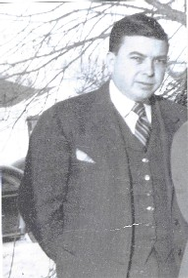
|
William W. Paul - Deputy Sheriff
Garvin County Sheriff’s Office February 15, 1947
On Wednesday, February 12, 1947, Deputy Sheriff William Paul, 40, and his partner, Deputy Sheriff Alfred Lon Pearson, were alerted by officers in Duncan, to arrest a local resident, J.W. Beasley, for a forgery that occurred in Stephens County. The deputies picked up Clarence Mays, a retired farmer from Maysville, who knew J. W. Beasley to help them identify the man.
About 3:30 p.m., they saw J. W. Beasley riding a motorcycle on Highway 19 near Meridian Road west of Pauls Valley. When the deputies stopped Beasley, he pretended to have engine trouble and asked them for a pair of pliers. Having distracted the officers, J. W. Beasley then opened fire on the deputies, wounding both deputies as well as Clarence Mays before escaping.
Deputy Sheriff Alfred Pearson died at the scene while Deputy Sheriff William Paul and Clarence Mays were rushed to the hospital. Deputy Sheriff William Paul was shot through the jaw and Clarence Mays was shot behind one ear. Over the next few days officers learned more about the fugitive J. W. Beasley. Beasley had been dishonorably discharged from the U.S. Navy during World War II at the age of seventeen and was convicted of armed robbery in California. J. W. Beasley was currently an escapee from the Correctional Institute for Men in Chino, California.
J. W. Beasley was later shot and killed by Oklahoma Highway Patrol Trooper Howard Hill after a lengthy foot chase when Beasley pulled a sawed-off shotgun on the state trooper.
Clarence Mays survived his wounds, but Deputy Sheriff William Paul died on Saturday, February 15, 1947.
Deputy Sheriff William Paul was survived by his wife Parnell and two sons and is buried in Mount Olivet Cemetery, Pauls Valley, Garvin County, Oklahoma.
OLEM – 7N-2-20 NLEOM – 49W1
Updated February 13, 2024
|
|
|
|
|
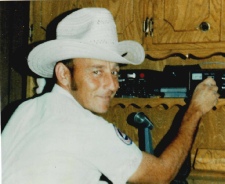
|
Clifford Phillip Payne - Deputy Sheriff
Washita County Sheriff’s Office June 18, 1977
On Saturday, June 18, 1977, Deputy Sheriff Clifford Payne, 38, and undercover narcotics agent, John Smith, were shot by the stepfather of Dean Melton as the officers tried to arrest the seventeen-year-old youth on a marijuana charge at his home about 1:30 a.m. Dean Melton’s stepfather, John Eakin, fired five rounds from a snub-nosed .38-caliber pistol, fatally wounding Deputy Sheriff Clifford Payne through the neck and striking Agent John Smith in the chin and left hand. John Eakin was wounded in the side by Agent John Smith who fired from the doorway of the residence as Agent Smith was seeking cover.
Dean Melton fled out the back door when the shooting began. He surrendered to authorities about 9:30 a.m. after a massive eight-hour search of the Burns Flat industrial district.
John Eakin was arrested and charged with murdering Deputy Sheriff Clifford Payne.
Deputy Sheriff Clifford Payne was survived by his wife of eighteen years, Peggy and three sons, Clifford Mark 17, Roy Brent 16, and Jeffery Wayne 14.
Clifford Payne is buried in Hydro Masonic Cemetery, Hydro, Blaine County, Oklahoma.
John Eakin testified at his trial that he thought Deputy Sheriff Payne was an armed intruder in his home that night and cited the fact that Deputy Sheriff Payne had a beard and long hair. The prosecution countered that Deputy Sheriff Clifford Payne was dressed in his uniform. On October 20, John Eakin was acquitted of murder by a jury.
OLEM – 1N-3-21 NLEOM – 28W13
Updated June 17, 2024
|
|
|
|
|
|
Alfred Alonzo “Lon” Pearson - Deputy Sheriff
Garvin County Sheriff’s Office February 12, 1947
Alfred A. Pearson was born in Oklahoma on April 18, 1888. Alfred Lonzo Pearson, 22, married Willie Rambo, 22, on October 8, 1910, in Altus, Jackson County, Oklahoma.
On Wednesday, February 12, 1947, Deputy Sheriff “Lon” Pearson and his partner, Deputy Sheriff William “Bill” Paul, were alerted by officers in Duncan, Oklahoma, to arrest a local resident, J.W. Beasley, for a forgery that occurred in Stephens County. The deputies picked up Clarence Mays, a retired farmer from Maysville, who knew J. W. Beasley to help them identify the man.
About 3:30 p.m., the deputies saw J. W. Beasley riding a motorcycle on Highway 19 near Meridian Road west of Pauls Valley. When the deputies stopped Beasley, he pretended to have engine trouble and asked them for a pair of pliers. Having distracted the deputies, J. W. Beasley then opened fire on them, wounding both deputies as well as Clarence Mays before escaping.
Deputy Sheriff “Lon” Pearson died at the scene while Deputy Sheriffs Bill Paul and Clarence Mays were rushed to the hospital. Deputy Sheriff Bill Paul was shot through the jaw and Clarence Mays was shot behind one ear. Over the next few days officers learned more about the fugitive J. W. Beasley. Beasley has been dishonorably discharged from the U.S. Navy during World War II at the age of 17 and was convicted of armed robbery in California and was currently an escapee from the Correctional Institute for Men in Chino, California.
J. W. Beasley was later shot and killed by Oklahoma Highway Patrol Trooper Howard Hill after a lengthy foot chase when Beasley pulled a sawed-off shotgun on the trooper.
Deputy Sheriff William “Bill” Paul died of his wounds Saturday, February 15, 1947.
Clarence Mays survived his wounds.
Deputy Sheriff Alfred “Lon” Pearson was a World War I veteran and a former Police Chief of Stratford.
Alfred Pearson was survived by his wife, Willie, four sons and two daughters and is buried in Mount Olive Cemetery, Pauls Valley, Garvin County, Oklahoma.
OLEM – 7N-2-15 NLEOM – 7E3
Updated December 4, 2024
|
|
|
|
|
|
Benjamin F Pearson - Deputy Sheriff
Atoka County Sheriff’s Office October 14, 1910
A dance was held at a local home near Caney on the evening of Friday, October 14, 1910. A man named George Brown had been hired to play the fiddle at the dance. George Brown showed up at the dance drunk and disorderly and was told to leave. Becoming very angry, George Brown drew a .32 caliber automatic pistol and began shooting out the lights and windows. Partygoers left the dance and one of them summoned Deputy Sheriff Ben Pearson from Caney.
About 10 p.m. as Deputy Sheriff Benjamin Pearson along with a Deputy Sheriff Sanders were in route to the dance they came upon George Brown and two companions walking on the road toward them. As the deputies approached George Brown, Deputy Sheriff Benjamin Pearson demanded that Brown surrender his weapon, Brown instead shot Deputy Sheriff Benjamin Pearson twice, once in the heart and once in the stomach killing him.
Deputy Sheriff Sanders, unarmed, was unable to prevent George Brown from escaping. A large posse was soon formed and began looking for the fugitive and a $750 reward was offered. It was suspected that George Brown escaped to Mexico where his father and brother lived as he was never located.
Deputy Sheriff Benjamin Pearson was survived by his wife Delta, 14-year-old daughter Pearley and 10-year-old son Leroy.
Deputy Benjamin Pearson is buried in Stringtown Cemetery, Stringtown, Atoka County, Oklahoma.
OLEM – 8S-1-5 NLEOM – 28E27
Updated October 11, 2023
|
|
|
|
|
�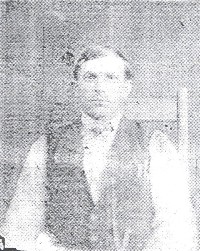
|
Thomas Newton "Newt" Pearson - Deputy Sheriff
McIntosh County Sheriff’s Office June 13, 1909
On Saturday, June 12, 1909, Deputy Sheriff Thomas Pearson attempted to serve an arrest warrant on a black man named Winton Irwin near the railroad depot near the small town of Hoffman. Winton Irwin struggled with Deputy Sheriff Pearson and managed to get Deputy Sheriff Pearson’s gun and escape.
Deputy Sheriff Thomas Pearson formed a posse which included his brother, Lon and General Thomas. On the evening of Sunday, June 13, 1909, they had tracked and found Winton Irwin on an island in the Deep Fork Creek three miles from Hoffman. The deputies waited in ambush for their suspect. As Winton Irwin walked by them, Deputy Sheriff Thomas Pearson stood up with a shotgun demanding the suspect surrender. Winton Irwin shot Deputy Sheriff Pearson fatally in the head with the deputy’s gun he had taken from him the previous day. The two posses opened fire on Irwin, hitting him in the head, right arm, side and abdomen. Despite his wounds, Winton Irwin ran off but collapsed about a mile away where the two officers apprehended him. Both officers marveled that Irwin had made it that far because of the extent of his wounds.
Winton Irwin died the next day while being transported to Checotah.
Deputy Sheriff Thomas Pearson was survived by his wife Priscilla, their two young children and ten children from a previous marriage.
Thomas Pearson is buried in Indian Territory Checotah Cemetery, Checotah, McIntosh County, Oklahoma.
OLEM – 1N-2-28 NLEOM – 42W23
Updated June 3, 2024
|
|
|
|
|
|
Joseph G. Peavy – Deputy U.S. Marshal
U.S. Marshal Service
According to the National Archives Joseph G. Peavy was commissioned as a Deputy U.S. Marshal on December 23, 1871, with his last name spelled Peevy, on July 9, 1872, with his last name spelled Peevey and again on July 9, 1878, with his last name spelled Peavy.
Peavy’s name is included on the Fort Smith Honor Roll for the year 1878. His name is not listed on the U.S. Marshal’s Memorial in Fort Smith, Arkansas, or the National Law Enforcement Officers Memorial in Washington, D.C.
Deputy U.S. Marshal Joseph Peavy was involved in the shootout at the Whitmire Schoolhouse east of Tahlequah, near the modern town of Christie in Adair County in the Going Snake District of the Cherokee Nation, along with Deputy U.S. Marshal Jacob Owens and others, mostly members of the Beck family on April 15, 1872. Deputy Marshal Peavy was first reported as killed in the shootout but later it was determined that he was unharmed.
There is no record of Joseph G. Peavy’s death.
OLEM – (1858 – 1867) 5N-1-7 (J G Peavy)
Updated December 4, 2024
|
|
|
|
|
|
Marshall Henry Pebsworth - Deputy Sheriff
Rogers County Sheriff’s Office March 21, 1957
On Thursday, March 21, 1957, Deputy Sheriff Marshall Pebsworth, 39, was returning from Coffeyville, Kansas, to Claremore. Deputy Sheriff Pebsworth had been to Coffeeville on a larceny investigation. In the car with Deputy Sheriff Pebsworth was Richard Owen Hendricks. At the north edge of Talala, on US 169, a vehicle passed Deputy Sheriff Pebsworth traveling about eighty miles per hour and Deputy Sheriff Pebsworth increased his speed to catch the speeding vehicle. Deputy Sheriff Pebsworth lost control of his vehicle, which slid about two-hundred-eighty-seven feet broadside, and then overturned four or five times, crashing into a telephone pole. The speeder Deputy Sheriff Pebsworth was chasing drove on in to Talala, summoned an ambulance and notified the highway patrol. Richard Hendricks survived the accident, but Deputy Sheriff Marshall Pebsworth died at the scene.
Deputy Sheriff Marshall Pebsworth was survived by his second wife Mae Dean, two sons, William Dean, 9, and Marshall, Jr, 19, and two daughters, Dorothy, 16, and Mrs. Gloria McWilliams.
Marshall Pebsworth is buried in Woodlawn Cemetery, Claremore, Rogers County, Oklahoma.
OLEM – 1N-1-14 NLEOM –
Updated March 17, 2024
|
|
|
|
|
|
Henry Peckenpaugh - Deputy U.S. Marshal
U.S. Marshal Service November 27, 1899
W.A. Cox was the postmaster of the small town of Wilburton, located about twenty-five miles east of South McAlester in the Indian Territory. At 8:30 p.m., Monday, November 27, 1899, after working on the books for several hours, Cox started walking home. It was his normal routine to take the daily receipts home with him, and this evening he had $240. While walking, W. A. Cox was approached by two men who demanded the money he carried. Cox refused and was knocked to the ground by the two men, who grabbed the moneybag and walked away. Cox’s cries for help were heard by Dr. W.A. Woodward, a dentist, and Deputy U.S. Marshal Henry Peckenpaugh, who were walking together on an adjacent street.
As Deputy Marshal Henry Peckenpaugh and Doctor Woodward ran toward the sounds of the cries, they observed two men walking toward them. Deputy Marshal Peckenpaugh told the men to stop, grabbing one of the men by the slicker he was wearing. The man spun, slipping Deputy Marshal Peckenpaugh’s hold, drawing his revolver at the same time. Deputy Marshal Peckenpaugh was in the process of drawing his gun when a shot rang out and the deputy marshal staggered a few steps and then fell into the street. The two suspects ran, leaving behind a slicker, one glove and a mask.
Dr. Woodward and Postmaster Cox attempted to help Deputy Marshal Peckenpaugh but found he had been shot in the heart and was already dead. John Hart and Oscar Mickle were later arrested and held without bond for the murder of U.S. Deputy Marshal Henry Peckenpaugh.
Deputy Marshal Henry Peckenpaugh was survived by his wife Elizabeth and their five children, Byrdie,15, John,10, Daisey,7, Violet,5 and Luke,2.
Henry Peckenpaugh is buried in the Englewood Cemetery, Clinton, Henry County, Missouri.
OLEM – 10N-3-6 NLEOM – 12W32
Updated November 20, 2023
|
|
|
|
|
|
John B. Pemberton - Deputy U.S. Marshal
U.S. Marshal Service February 20, 1892
John Benjamin Pemberton was born in Galatia, Illinois in 1867 to George Washington and Sophronia Harriet (Price) Pemberton. John was the second of seven children, four boys and three girls. John Pemberton married Dora A. Edwards in Saline, Illinois on February 14, 1889. Within a short time, the couple moved top Indian Territory where John took a job as a Deputy U.S. Marshal. John was called Benjamin or Berry by his friends.
Deputy Marshal John Pemberton was assigned an arrest warrant for William Payne, who had assaulted Deputy U.S. Marshal W.C. Simpson by striking Simpson in the head with a gun on Thursday, February 18, 1892, in Muldrow, Indian Territory, while Deputy Marshal Simpson was in a fight trying to arrest Jess Watts.
Deputy Marshal John Pemberton traveled from Muskogee to Muldrow on Friday evening with his posse named Woods. On Saturday morning, February 20, 1892, Deputy Marshal John Pemberton, and Posse Woods located William Payne and placed him under arrest. An agreement was made with William Payne that they would release him only if he promised to return to the train station that evening for transfer to Muskogee. William Payne agreed.
Deputy Marshal John Pemberton and Posse Woods waited only a short time at the station when William Payne arrived. William Payne thanked Deputy Marshal Pemberton for his kindness and said he was ready to go. As the three men waited for the train, a man named John Bailey, 21, approached them. The four men stood talking when either Posse Woods or John Bailey took offense at something that was said. A fight broke out between the two men. John Bailey broke Posse Woods’ grip and ran into a store. John Bailey shortly reappeared with a rifle and started firing, hitting Deputy Marshal John Pemberton in the left chest. Deputy Marshal John Pemberton then dropped to the ground and died a few minutes later. Posse Woods returned fire causing John Bailey to run from the area. Posse Woods then went to aid his partner Deputy Marshal John Pemberton but discovered there was nothing he could do; Pemberton was already dead.
Deputy Marshal John Pemberton’s burial site is unknown.
John Bailey was soon arrested for the murder of Deputy Marshal John Pemberton and taken to Fort Smith for trial. John Bailey claimed that Posse Woods attacked him for no reason and that he broke away and ran to the store to get a rifle and as he came out of the store Deputy Pemberton and Posse Woods started shooting at him and he returned fire. When it was pointed out that Deputy Marshal Pemberton’s gun was fully loaded when checked after the shooting Bailey claimed that Pemberton sat in the street and reloaded his gun and put the spent cartridges in his pocket. Despite the evidence and ridiculous claim of Deputy Pemberton reloading his gun while sitting in the street the jury found John Bailey not guilty.
OLEM – 10S-3-3 NLEOM – 26W6
Updated February 13, 2024
|
|
|
|
|
|
Steve Pen-Su-Wau (Pensoneau) - Posseman , Deputy U.S. Marshal
U.S. Marshal Service February 6, 1891
Pen-Su-Wau was also a sergeant of the Kickapoo, Pottawatomie, Iowa and Sac and Fox Indian Police.
The Oklahoma City Gazette of February 12, 1891, reported that Pen-Su-Wau had acted as a posse for Frank Cochran and Sheriff DeFord during the arrest of several parties in his neighborhood.
Deputy U.S. Marshal Preston Armstrong had an arrest warrant to serve and expected the man named on the warrant to ride along a certain road. Deputy Armstrong secreted himself by the roadside and waited for his suspect. Pen-Su-Wau was riding the same road on his way home and as he approached Armstrong stepped out and commanded the Indian policeman to halt. Pen-Su-Wau refused and Armstrong shot him out of the saddle, falling into the dirt, dead. Armstrong stated he had fired with his six-shooter, although some witnesses claimed he fired with a shotgun.
According to a report printed in the Oklahoma State Capitol of Guthrie on February 21, 1891, Deputy Armstrong came in from Shawnee Town the night of the 6th to face trial the following day. A coroner’s jury was impaneled on the morning of the 7th, returning a verdict of justifiable homicide. John Decker testified that Armstrong had stopped him when Pen-Su-Wau rode up on a horse. Armstrong told him to halt, Pen-Su-Wau refused, firing a shot at Armstrong and it was then that Armstrong shot him, firing eight or nine shots, hitting Pen-Su-Wau five times.
Another report at the Oklahoma State Capitol on November 22, 1894, Deputy U.S. Marshal Frank Cochran brought Captain S.J. Scott, Ex-Sheriff James H. Gill, Deputy U.S. Marshal Preston Armstrong and Daniel Brestman into Guthrie and jailed them on charges of killing Pen-Su-Wau. A separate report states that Pen-Su-Wau was killed by three deputy marshals who mistook him for Bob Counallis or George Howell, both noted outlaws who the marshals were looking for.
On February 12, 1895, the Guthrie Oklahoma State Capitol reported that Chief Deputy U.S. Marshal John M. Hale and posses left on a train bound for Brooklyn Penitentiary with George Howell who was sentenced to ten years in prison for the killing of Pen-Su-Wau, who was “acting as posseman under Deputy United States Marshal Armstrong.”
Steve Pen-Su-Wau (Pensoneau) was survived by his wife and several small children.
The burial site of Steve Pen-Su-Wau is unknown.
OLEM – 4N-2-4 NLEOM – 11E1
Updated February 4, 2024
|
|
|
|
|
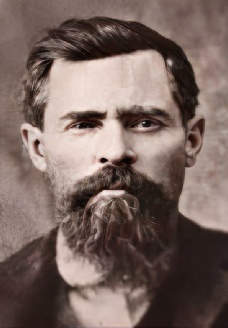
|
Jesse Simmons “Jack” “Parson” Perkins – Posse - Deputy U.S. Marshal
U.S. Marshal Service March 17, 1891
In 1889 Texas outlaws Bill Hudgins, 21, and Alex Davis, 20, moved across the Red River from Texas into the Chickasaw Nation. Bill Hudgins and Alex Davis were wanted in Texas for many crimes ranging from forgery, robbery, horse theft and murder.
For the next two years Bill Hudgins and Alex Davis and a gang they put together committed seventeen cases of horse theft, fifteen armed robberies, eight murders plus several cases of robbery of U.S. Mail and one attempted train robbery in mid-November 1889 at Berwyn Station located just west of Ardmore.
Early the morning of Tuesday, March 17, 1891, Deputy U.S. Marshals Bill Stewart, Jim Chancellor, and D. E. Booker, along with their posse, prepared to raid the house of Bill Poe, believed to be one of the members of the Hudgens – Davis gang. The house was located on Henry House Creek, near Woodford which was about eighteen miles northwest of Ardmore.
Deputy Marshal Bill Stewart’s posse, Jesse “Parson” Perkins, 43, an ordained Methodist minister and well-respected lawman, had developed information that Alex Davis and Bill Poe were in the house. The rest of the gang had been captured at a line house near Mill Creek following a shootout with other deputy marshals the month before on March 5th including Bill Hudgens who was seriously wounded. Alex Davis was also wounded in the arm but had escaped.
The lawmen surrounded the Bill Poe house and demanded the outlaw’s surrender. As expected, the officers’ demand was met with gunfire. During the return fire Deputy Marshal Jim Chancellor shot Alex Davis in the right chest taking him out of action. Bill Poe then fired back at Deputy Marshal Jim Chancellor, but his shot missed its target and hit Posse Jesse “Parson” Perkins in the abdomen. Several more shots were exchanged before the two outlaws gave up and surrendered.
Alex Davis was taken to a hotel and treated for his wound and Bill Poe was placed in jail.
Posse Jesse “Parson” Perkins died later that Tuesday evening from his gunshot wound.
Jesse “Parson” Perkins was survived by his wife Martha and their eight children, ages 23 to 7 years of age.
The burial site of Jesse S. “Parson” Perkins is unknown.
Bill Poe was later convicted of manslaughter in the death of Posse Jesse “Parson” Perkins and sentenced to a ten-year prison term in the Detroit, Michigan prison where the rest of his gang was also sent to pay for their numerous crimes.
OLEM – 12S-2-1 NLEOM – 58E34
Updated May 1, 2024
A special thank you to Robert “Bob” Ernst for his help with researching this fallen officer.
|
|
|
|
|
|
Isaac “Art” “Ike” Person – Deputy Sheriff
Le Flore County Sheriff’s Office October 6, 1920
Isaac Person was born on October 8, 1875, to Abraham and Annie Marie “Boase” Person at East Bloomfield, Ontario County, New York. By 1894 Isaac Person was living in Braden, in Indian Territory. On July 25, 1894, Isaac Person, then 21, married 18-year-old Elizabeth “Lizzie” Howard in Sabastian County, Arkansas. Isaac and Elizabeth had ten children. The youngest, Johnnie, died at a very young age in 1898.
By December1920, IsaacPerson had been a Deputy Sheriff for Le Flore County in Indian Territory for twelve years. On Monday, December 6, 1920, Deputy Sheriff Isaac Person had deputized Bert McKenzie to assist him in serving arrest warrants for bootlegging on Henry and Adale Toney at their residence at Fort Coffee, a negro settlement in Le Flore County, sixteen miles west of Fort Smith, Arkansas.
The two unarmed officers went to the Toney residence about 4:30 p.m. that Monday afternoon to serve the arrest warrants. As the officers entered the residence they were set upon by the Toneys and another man and beaten about the head into insensibility with rifles. Frank McKenzie, a brother of Bert McKenzie had followed the officers and observed the brutal assault on the two officers in the doorway of the Toney residence.
The two officers were taken to a hospital in Fort Smith were Deputy Sheriff Isaac Person died at 8:30 p.m. that evening. Special Deputy Sheriff Berty McKenzie though seriously injured, survived his head injuries.
Isaac Person was survived by his wife Elizabeth and nine children, Henry Ike, 25, Annie, 20, Robert Isaac, 18, Pansy, 16, Madge Belle, 14, Estral Mae, 12, Woodrow Wilson, 7, Clifford Larken, 5, and Fredrick H., 2.
Deputy Sheriff Isaac Person is buried in New Hope Garden of Memories Cemetery, Spiro, Le Flore County, Oklahoma. Elizabeth was buried next to him in 1957.
OLEM – 10N-2-19 NLEOM –
Updated October 5, 2024
|
|
|
|
|
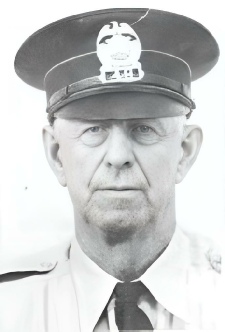
|
James S. Peters - Officer
Tulsa Police Department April 14, 1949
James Peters joined the Tulsa Police Department in 1928. He was laid off in 1933 but rehired in 1936. In 1949, Officer James Peters, 76, was one of only two-foot patrolmen on the Tulsa force.
Shortly before midnight on Thursday, April 14, 1949, Officer James Peters was walking behind the Dickson-Goodman Lumber Company, 2712 W. 40th Street, when he discovered a burglar had entered the rear of the building. A witness saw Officer Peters checking the inside of the building when a man fired at the officer several times. Officer James Peters was shot once in the right hand and three times in the chest with a .45 caliber pistol and died at the scene only four blocks from his home.
Officer James Peters was survived by his wife Nora.
James Peters is buried in the Clinton Oaks Cemetery, Red Fork, Tulsa County, Oklahoma.
No one was ever arrested for Officer James Peters’ murder.
OLEM – 7N-3-19 (P) NLEOM – 29W3
Updated April 13, 2024
|
|
|
|
|
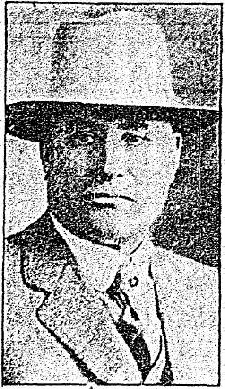
|
Clarence H. "Red" Phillips - Sheriff
Beckham County Sheriff’s Office June 21, 1930
On Saturday, June 21, 1930, Sheriff Clarence Phillips, and his deputies busted two stills in two days. One still along with three barrels of mash had been at the home of Frank F. Griffin. Sheriff Phillips went back to his office about 9:00 p.m. that night to do paperwork. Undersheriff Inman was spending the night on the floor above Sheriff Clarence Phillips’ office when shortly before 10:00 p.m. he heard four shots downstairs. Undersheriff Inman ran downstairs only to find Sheriff Phillips dead, shot four times in the head and chest with a 7.5-millimeter Luger. Sheriff Phillips was unarmed, lying on his back with his hands hooked in his suspenders, a characteristic stance of his.
A Rock Island Railroad officer reported that some men had approached him trying to borrow a gun. Within fourteen hours, Joe Pounds, Frank Griffin and Jess Brown were in jail. Frank Griffin, the owner of the still Sheriff Phillips had smashed the previous day, supplied the Luger used in the murder. The three men had been drinking after the raid on Griffin’s still and decided to get revenge on Sheriff Clarence Phillips. Joe Pounds was one of Sheriff Phillips’ former deputies who Phillips had fired several months before for stealing confiscated liquor. All three men were convicted and sentenced to life in prison.
Clarence Phillips was single and is buried in Fairlawn Cemetery, Elk City, Beckham County, Oklahoma.
OLEM – 8S-5-12 NLEOM- 56E25
Updated June 19, 2024
|
|
|
|
|
|
John Phillips - Deputy U S Marshal
U. S. Marshal Service June 30, 1888
On Saturday evening, June 30, 1888, Deputy U.S. Marshal John Phillips and his posse William Whitson, son of Deputy U. S. Marshal Cal Whitson, had gone twenty miles east of Eufaula and waited in hiding along a trail in the area of a “green corn” dance in an attempt to locate Daniel Thompson, a Creek Indian prisoner who had escaped from them earlier.
The officers also had warrants for a Creek Indian bootlegger, robber and murderer named Wesley Barnett and one of his gang, a Ute Indian named San Lopka but did not expect to encounter them that night.
Soon the officers observed three men riding down the trail toward them. The men were San Lopka, Wesley Barnett and his brother Watie. When the officers stopped them the men thought they were being arrested and quickly drew their guns and started shooting.
In the gun battle Deputy Marshal John Phillips, posse William Whitson and Watie Barnett were killed.
John Phillips was survived by his wife and was buried at Eufaula, McIntosh County, Oklahoma but his exact burial site is unknown.
Wesley Barnett was killed January 13, 1889, in another shootout with Deputy U. S. Marshal Wallace McNac.
OLEM – 5N-3-1 NLEOM – 31W1
Updated June 27, 2024
|
|
|
|
|
|
William M. "Billy" Phillips - Sheriff
Pottawatomie County Sheriff’s Office December 25, 1980
William M. Phillips was born March 28, 1922, at Maud, Pottawatomie County, Oklahoma to Ulmond A. and Mary Willie (Mitchell) Phillips. In 1952 William M. Phillips married Oletha Pearl (last name unknown).
On the night of Wednesday, December 3, 1980, Sheriff William Phillips, 58, was involved in a traffic accident at the intersection of Market and McArthur Streets in Shawnee. One of his legs was badly broken and required surgery. Sheriff William Phillips was released from the hospital on Tuesday, December 23rd. Shortly after noon two days later, on Christmas Day, Sheriff William Phillips died from a heart attack caused by a blood clot from the leg injury.
Sheriff William Phillips was survived by his wife Oletha.
William “Billy” Phillips is buried in the Resthaven Cemetery, Shawnee, Pottawatomie County, Oklahoma.
OLEM – 2N-1-14 NLEOM – 3W10 [Billy M]
Updated December 23, 2023
|
|
|
|
|
|
William Leantine Pitts - Deputy U.S. Marshal
U.S. Marshal Service November 30, 1890
William Pitts was born on September 21, 1846, in Pontotoc, Mississippi, the youngest of six children born to Carey and Sarah Ann (Lark) Pitts. By the 1870’s Wiliam Pitts lived in Paris, Texas. William Pitts worked as a Deputy U.S. Marshal for the Eastern District of Texas.
In November of 1890 Deputy Marshal William Pitts was relocated from Paris, Texas, to McAlester in the Choctaw Nation of the Indian Territory. On Sunday, November 30, 1890, Deputy Marshal William Pitts traveled to Lake West where he started a surveillance point after being informed that three Indians were smuggling liquor into Indian Territory from Texas. Deputy Marshal William Pitts soon spotted a wagon traveling north occupied by three Indians. Deputy Marshal Pitts stepped out of the brush and stopped the wagon. The Indians identified themselves as Isam Frazier, Lige Woods and Jim Allen. Deputy Marshal Pitts told the three men that he suspected they were transporting illegal liquor and he was going to search their wagon. An argument ensued and escalated into a struggle. As Deputy Marshal William Pitts fought to control the three men, his gun was ripped out of its holster, and he was shot in the stomach. Deputy Marshal William Pitts staggered back, dropped to the dirt, and died within minutes. The three men quickly left the area.
Neighbors found Deputy Marshal William Pitts’ body and reported the killing to the U.S. Marshal’s office in Paris, Texas.
Deputy Marshal William Pitts is buried in New Salem Cemetery, Fannin County, Texas.
The three Indian men were captured and jailed in Paris, Texas. All three men pled not guilty. Due to several delays, the trial was not conducted until May 1891 and a verdict returned on May 21st. Isam Frazier was found guilty of manslaughter. Jim Allen and Elijah Wood were acquitted of the shooting. Isam Frazier was sentenced to a lengthy term in prison.
OLEM – 9N-3-10 NLEOM – 26W6
Updated November 28, 2023
|
|
|
|
|
|
Edward Stephen "Ed" Plank - Deputy U.S. Marshal
U.S. Marshal Service July 23, 1914
Just after noon on Thursday, July 23, 1914, Deputy U.S. Marshal “Ed” Plank, 47, Deputy U.S. Marshal Holmes Davidson, 52, and Deputy U.S. Marshal Ike Wilkinson went to the home of William Baber, at 823 West Fifth in Tulsa. The marshals had a search warrant for the house to look for illegal liquor. William Baber had a long record of liquor violations and was currently waiting to start a two-year prison term for conviction of bootlegging. Baber had previously been the Chief of Police at Tulsa but had been ousted from that position and had then taken up bootlegging as a means of making a living.
When the deputies arrived at the Baber home, Deputy Marshal Ike Wilkinson headed to the back of the house, while deputies “Ed” Plank and Holmes Davidson went to the front door and knocked. Mrs. Baber answered the door, opening the inner door, keeping the screen door shut. Deputy Marshal Davidson stated they were going to search the house at which time Mrs. Baber denied them entrance. William Baber then came to the door, again denying the deputies entrance. Deputy Marshal Holmes Davidson started to draw his gun, at which time William Baber grabbed a double-barreled shotgun and fired one barrel into Deputy Marshal Holmes Davidson’s neck and shoulder. William Barber then turned toward Deputy Marshal “Ed” Plank and fired the other barrel into Plank’s chest. Deputy Marshal Davidson turned and started walking toward the street when he collapsed and died. Deputy Marshal Plank staggered a couple of steps and then fell to the ground. William Barber then reloaded and fired at a retreating Deputy Marshal Ike Wilkinson but missed him.
William Baber then called the police and confessed to killing both Deputy Marshal Davidson and Deputy Marshal Plank. Tulsa Police would later say that Deputy Marshal Holmes Davidson’s gun was in his hand when he was found but it had not been fired. William Barber was arrested and in 1917 the case finally came to trial and a jury found William Baber guilty of two counts of manslaughter and the court sentenced him to four years in prison.
Edward Plank had served as the Chief of Police of Claremore before becoming a Deputy U.S. Marshal.
Deputy Marshal Edward Plank was survived by his wife Sarah and three daughters and is buried in Woodlawn Cemetery, Claremore, Rogers County, Oklahoma.
OLEM – 8S-1-6 NLEOM – 13E16
Updated January 10, 2024
|
|
|
|
|

|
Charles "Edward" Plowman "Ploughman" - Special Constable
City of Binger July 13, 1905
During the summer of 1905, Thurston C. Renfro was the clerk of the local school board in Binger. Although he contended that his term was not up for another two years, another election was held, and a new clerk was elected. Thurston Renfro refused to turn over any records to the newly elected school board clerk and a warrant of replevin was issued on Monday, July 10th.
Edward Plowman was appointed a Special Constable to serve the warrant of replevin. On the morning of Wednesday, July 12th Special Constable Edward Plowman went to Thurston Renfro’s home to obtain the books. Thurston Renfro refused to turn the books over to Constable Plowman. Constable Plowman left and obtained an arrest warrant for Thurston Renfro for resisting an officer in the service of process and refusing to deliver the property. On Thursday, July 13, 1905, Special Constable Edward Plowman went to serve both warrants accompanied by Thomas Gibbons, Director of the local school district.
The two men found Thurston Renfro near his home. Constable Edward Plowman told Renfro he was under arrest and Renfro did not protest. Constable Plowman then told Renfro he was going to search his house for the missing records and at that time Renfro ran into his house and advised the men not to come in without a search warrant. As Constable Plowman and Thomas Gibbons approached the east door of the house Thurston Renfro started shooting. Constable Plowman ran to the southeast corner of the house. Thurston Renfro ran out of the west door and to southwest corner of the house where he saw Constable Plowman and shot him in the back with his 25-35 Winchester rifle killing him.
When the shooting was over, however, Thurston Renfro and Constable Edward Plowman were both dead. Thomas Gibbons was charged with the murder of Thurston Renfro, convicted, and sentenced to life in prison. A few years later the State Supreme Court overturned the conviction and ordered a new trial.
Constable Edward Plowman was survived by his wife Adah Edith (Atkins)and three young children and is buried in Spring Creek Cemetery, Spring Creek, Caddo County, Oklahoma.
Many newspaper articles of the time spelled Constable Charles Edward Plowman’s last name as Ploughman.
OLEM – 5N-3-22 (Ploughman) NLEOM – 50E27 [Ploughman]
|
|
|
|
|
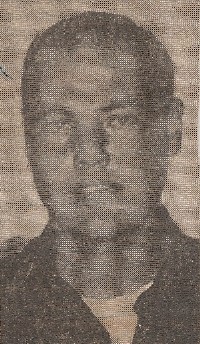
|
Herbert G. Poe - Police Officer
Ardmore Police Department March 23, 1970
On Monday, March 23, 1970, Officer Herbert Poe ended his shift at the Ardmore Airpark at 4 a.m. Parking his police car, Officer Poe got on his 1970 Honda motorcycle and started home. Officer Herbert Poe drove a block and a half before a Frisco Railroad switch engine and a flatcar loomed up ahead of him. Officer Herbert Poe’s motorcycle left twelve feet of skid marks and then Officer Poe apparently laid the motorcycle on its side and skidded another for sixty-five feet. Officer Herbert Poe was attempting to get the motorcycle back on its wheels when he smashed into the steps at the rear of the switch engine. Officer Herbert Poe, 26, was killed instantly.
Officer Herbert Poe was survived by his wife Jean, a daughter, Shana; two sons, Chad and a new son born two hours after Officer Herbert Poe was killed.
Herbert Poe is buried in Hillcrest Memorial Park Cemetery, Ardmore, Carter County, Oklahoma.
OLEM – 1N-1-22 NLEOM – 45W1
Updated December 5, 2024
|
|
|
|
|
|
John Poe - Deputy U.S. Marshal
U.S. Marshal Service September 25, 1901
John Poe was appointed a Deputy U.S. Marshal by U.S Marshal John Hammer of the Southern District of Indian Territory.
On Wednesday, September 25, 1901, Deputy Marshal John Poe and his posse, J.H. Neely, boarded the northbound Frisco train in Denison, TX. The trip was peaceful until the train was approaching Ravia, a small town three miles west of Tishomingo, I.T. Deputy Marshal John Poe walked toward the rear of the train. As Deputy Marshal Poe entered the smoking car, he noticed B. W. Taylor causing a disturbance. Deputy Marshal Poe identified himself and then advised Taylor to settle down or he would arrest him. An argument started and Deputy Marshal Poe told B. W. Taylor he was under arrest for disturbing the peace. As Deputy Marshal Poe tried to handcuff him, Taylor jumped Deputy Marshal Poe and a fight ensued.
Another passenger went and advised posse J. H. Neely of the fight. As Posse Neely entered the rear of the train, he saw Deputy Marshal Poe trying to handcuff Taylor. Dave Bruner got up and headed toward Deputy Marshal Poe. Posse Neely charged Dave Bruner and knocked him to the floor with the butt of his gun. George Yargee then got up from his seat and headed toward Deputy Marshal Poe and was also knocked to the floor by Posse Neely. B. W. Taylor broke away from Deputy Marshal Poe and then knocked Posse Neely to the floor, at the same time grabbing posse Neely’s gun. Deputy Marshal Poe tackled B. W. Taylor and all three men began a desperate fight for control of the gun. As the fight continued a shot rang out and Deputy Marshal John Poe dropped to the floor dead. A bullet had entered the right side of his chest, traveled through the chest, and exited out of the left side.
Posse J. H. Neely was able to gain control of B. W. Taylor, his son Ben, Dave Bruner, and George Yargee at gunpoint. Posse Neely turned the prisoners over to Deputy U.S. Marshal Bridges upon the train’s arrival at Mill Creek. Deputy Marshal Bridges took the prisoners to Ardmore where they were jailed to await trial. When the trial was over, the judge released Dave Bruner, Ben Taylor, and George Yarhee due to a determination that they were not involved in the actual shooting. The judge further stated that the evidence was inconclusive as to who had control of the gun when it went off and therefore, he had no choice but to release B.W. Taylor with no charges.
Deputy Marshal John Poe is buried in Mill Creek Cemetery, Mill Creek, Johnston County, Oklahoma.
OLEM – 5N-5-4 NLEOM – 10E16
Updated September 22, 2023
|
|
|
|
|
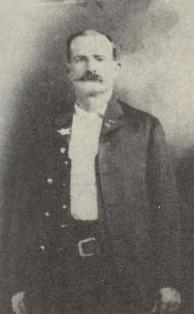
|
Calvin Warnell Polk - Officer
Holdenville Police Department January 22, 1904
Before coming to Oklahoma Territory, Calvin Polk was part of the posse that captured Billy the Kid at Stinking Springs, New Mexico in December 1880.
Calvin Polk served as the Deputy Sheriff at Holdenville, Creek Nation before joining the Holdenville Police Department.
About noon Friday, January 22, 1904, Officer Calvin Polk, 41, was home alone cleaning his six-shot revolver. He had the handles off, and five cartridges extracted and laying on the floor. This is the usual number of cartridges he carried in his revolver, and it is believed that he did not know the sixth cartridge was in the gun and that it was accidentally discharged. The bullet struck him in the forehead. His wife Annie was next door visiting a neighbor when the accident happened. Shortly after the accident some of Officer Calvin Polk’s six children came home from school and found their father on the floor with the wound to his head but still alive. Officer Calvin Polk died later that same day.
Calvin Polk was survived by his wife Anna Melvina (Hampton) and their six children. Only four of their children’s names and ages when Calvin died are known. Christopher Warner, 19, Julius, 16, Ora Lee, 14, and Katie Bell, 10.
Calvin Polk is buried in Holdenville Cemetery, Holdenville, Hughes County, Oklahoma.
OLEM – 1N-2-24 NLEOM – – –
Updated January 16, 2024
|
|
|
|
|
|
John Poorbear - City Marshal
City of Fort Gibson September 23, 1890
Tom and Jim French, Dave Andrews and John Buchanan, all Cherokee Indians, were on a drinking spree on Sunday, September 14, 1890, in Ft. Gibson. City Marshal John Poorbear and a deputy tried to arrest the three men. As City Marshal John Poorbear was struggling with Dave Andrews, Andrews fired one shot at the city marshal and then threw his gun away. City Marshal Poorbear was shot in the neck.
Paralyzed from the gunshot wound, City Marshal John Poorbear died on Tuesday, September 23, 1890.
The burial sight of John Poorbear is unknown.
Dave Andrews was convicted of killing City Marshal John Poorbear and sentenced to be hung on December 10th but was pardoned by Cherokee Chief Mayes before the sentence could be carried out.
OLEM – 10N-1-4 NLEOM –
Updated September 22, 2023
|
|
|
|
|
|
Josiah Poorboy - Posse, Deputy U.S. Marshal
U.S. Marshal Service December 8, 1891
In early December 1891 a charge of adultery was filed against Jim Craig in federal court in Fort Smith, Arkansas. The indictment alleged Jim Craig had been sexually involved with Annie Hitchcock. Jim Craig has been arrested by Deputy U.S. Marshal Charles Lamb but had escaped from custody. Deputy Marshal Charles Lamb planned a way to capture Jim Craig by sending in an undercover operative to locate him. Thomas Whitehead agreed to infiltrate the area, locate Jim Craig, and make the arrest. Thomas Whitehead was appointed a Deputy U.S. Marshal. Deputy Marshal Whitehead then appointed Josiah Poorboy, a young Cherokee, as his posse.
On Tuesday, December 8, 1891, Deputy Marshal Thomas Whitehead, 19, and his posse, Josiah Poorboy, were staying at Cherokee Nation Judge L. W. Shirley’s home to keep watch on the house of Annie Hitchcock. Annie was the daughter of Judge Shirley.
Annie Hitchcock asked Waco Hampton, an escapee who had been convicted of manslaughter, John Brown, a white man living with Waco Hampton’s stepfather, and John Roach, another young man who was friends with Waco Hampton and John Brown, to kill Deputy Marshal Whitehead and Poorboy.
The three men went to the home of Judge Shirley and Waco Hampton called for Deputy Marshal Thomas Whitehead to come outside. The two lawmen came out carrying rifles. Waco Hampton leveled a rifle at Posse Josiah Poorboy and fired, while John Brown fired at Deputy Marshal Whitehead who went down and died within minutes. Posse Josiah Poorboy kept firing until he was shot and fell to the ground dead. John Roach had been wounded and lay moaning on the ground. Waco Hampton and John Brown fled and were not located until January 30, 1892, when Deputy U.S. Marshal C. A. Bruner attempted to arrest them. Waco Hampton fired on Deputy Marshal Bruner when ordered to surrender. Deputy Marshal Bruner had a double barrel shotgun and opened fire on Waco Hampton killing him and his horse. John Brown was then taken into custody.
Deputy U.S. Marshal Thomas Whitehead is buried in Martin Cemetery, Siloam Springs, Benton County, Arkansas.
The burial site of Posse Josiah Poorboy is unknown.
John Roach recovered from his wounds and testified against John Brown. John Brown was tried, found guilty and sentenced to be hung by Judge Isaac C. Parker. After several appeals, on December 24, 1896, John Brown pled guilty to manslaughter and was sentenced to one year in the Columbus, Ohio prison.
OLEM – 4N-3-1 NLEOM – 40W15
Updated December 5, 2023
|
|
|
|
|
|
Harry Leslie Potter - Deputy Sheriff
Beaver County Sheriff’s Office December 7, 1971
On Tuesday, November 30, 1971, Deputy Sheriff Harry Potter, 55, was investigating a traffic accident on the icy bridge over the Beaver River. Carl Taylor, 64, was approaching the bridge and had not noticed the accident scene. When Carl Taylor tried to stop, his vehicle began sliding on the icy bridge and struck Deputy Sheriff Harry Potter, pinning him against the bridge abutment. Deputy Sheriff Harry Potter was taken to the hospital with a broken right leg.
Deputy Sheriff Harry Potter died of complications from his injuries on Tuesday, December 7, 1971. Harry Potter was survived by his wife, four children and eighteen grandchildren and is buried in the Beaver Pioneer Cemetery, Beaver County, Oklahoma.
OLEM – 9N-2-3 NLEOM – 54W15
Updated December 5, 2023
|
|
|
|
|
|
Albert Pike "Al" Powell - Deputy Sheriff
Rogers County Sheriff’s Office February 4, 1934
Albert Powell was born in Jones Borough, Arkansas on December 4, 1875. Albert Powell moved to Chelsea, Oklahoma Territory, just before 1900 and worked there as a drayman. Later Albert Powell served as Chelsea’s fire chief and was also commissioned as a Rogers County Deputy Sheriff.
About 1:30 a.m. Sunday February 4, 1934, Deputy Sheriff Albert Powell and Chelsea Night Marshal W. A. “Bud” Roberts saw two men walk away from the side of a closed hardware store in Chelsea. The officers turned their car around and stopped in the street. The two men started walking toward the officers’ car. When near the front of the car the two men opened fire on the two officers who were still setting in their car, killing Deputy Sheriff Albert Powell.
Deputy Sheriff Albert Powell was survived by his wife Mary Helen (Starms) and their seven children and is buried in Chelsea Cemetery, Chelsea, Rogers County, Oklahoma.
OLEM – 7N-1-16 (Earl Powell) NLEOM – 44E23
Updated January 30, 2024
|
|
|
|
|

|
Charles D. Powell - Foreman
Oklahoma Department of Corrections May 13, 1936
At noon on Wednesday, May 13, 1936, fourteen convicts in the Oklahoma State Penitentiary at McAlester, were eating lunch in the brick yard when they surrounded the four prison guards in the yard. The convicts, led by Julius Bohannon, Claud Beavers and William Anderson, were brandishing prison-made dirks. Threatening to kill the guards, they forced them to throw down their keys and weapons, then piled the guards into a commandeered automobile and drove through the gate with half a dozen prisoners hanging on to the running boards. During the attempted escape, Charles D. Powell, brickyard foreman, was shot in the head and his body dumped nearly a mile away on a McAlester thoroughfare.
Foreman Charles Powell was survived by his wife, a daughter and two sons.
Charles Powell is buried in South Heights Cemetery, Sapulpa, Creek County, Oklahoma.
Julius Bohannon was finally captured after two and a half months of freedom. He was tried before Judge R.E. Higgins, Pittsburg County, for the death of foreman Charles Powell. Although there was some question whether, during the escape, it was his shot or one from the guards that killed Charles Powell, Julius Bohannon pled guilty to the charge of murder. A second life term was added to the ninety-nine-year and life sentences he was already serving and cost him four and a half years in solitary.
Julius Bohannon would escape prison and be recaptured two more times, in 1947 and in 1955. He was given a full pardon by Governor Raymond Gary in 1958. Julius Bohannon lived out the rest of his life quietly in Texas dying in January 1983 at the age of 76.
OLEM – 8S-5-6 NLEOM – 57E22
Updated January 30, 2024
|
|
|
|
|
|
Joseph Thomas "Tom" Pratt - City Marshal
City of Madill November 6, 1910
Just after noon on Sunday, November 6, 1910, Madill City Marshal Joseph Pratt, 39, was called to a disturbance at the home of W. A. Thompson. Thompson’s son, Jim Thompson, was the cause of the disturbance. When City Marshal Pratt arrived Jim Thompson, who had hidden himself behind a fence, opened fire on City Marshal Joseph Pratt with a Winchester rifle. After shooting City Marshal Pratt to death, Jim Thompson made his get-away in a nearby horse and buggy. A posse of officers and armed citizens scoured the area for Jim Thompson.
City Marshal Joseph Pratt was survived by his wife and two sons and is buried in Eddy Cemetery, Falls County, Texas.
Jim Thompson was eventually arrested. On July 3, 1911, Jim Thompson was convicted of the murder of City Marshal Joseph Pratt and given a ten-year prison sentence.
OLEM – 9S-2-2 NLEOM – 63W25
Updated October 30, 2023
|
|
|
|
|
|
Richard Henry Pratt - City Marshal
City of Gore March 12, 1927
Richard H. Pratt was born March 12, 1880, in Missouri City, Fort Bend County, Texas.
The body of City Marshal Richard Pratt was found about 1:15 a.m., Saturday morning March 12, 1927, under a streetlight on the main road through Gore. City Marshal Pratt had been shot in the heart with a .38 caliber bullet and in the head with a .44 caliber bullet. Witnesses in the area reported hearing two shots just after midnight. It is believed that bootleggers in the area killed City Marshal Pratt as they had threatened him in the past.
It appears City Marshal Pratt had stopped a car that was speeding through town about 1:15 a.m. that Saturday morning. It is believed at least two persons were in the car and that they fired on City Marshal Richard Pratt who was holding his gun in his hand when shot twice. City Marshal Pratt’s gun had not been fired.
City Marshal Richard Pratt died on his forty-seventh birthday and was survived by his wife Dellar and their four young children.
City Marshal Richard Pratt is buried in Gore Cemetery, Gore, Sequoyah County, Oklahoma.
Early in the investigation two men were arrested but were soon released and afterwards no one was ever charged with City Marshal Richard Pratt’s murder.
OLEM – 10N-2-7 NLEOM – 36E23
Updated March 8, 2024
|
|
|
|
|
|
Marion Prickett - Possesman, Deputy U.S. Marshal
U.S. Marshal Service December 15, 1890
Marion Prickett was born in Indiana in 1854 to John and Ann Catherine (Bruss) Prickett.
By the early 1870’s Marion Prickett had relocated to Kansas. Marion met Martha Fulk in Montgomery, Kansas and they married on July 29, 1878. Four children were born to this union, George, Kitty, Stella, and Ernest. By 1890 Marion Prickett was riding as posse for Deputy U.S. Marshal Anderson Keen, who worked Western District of Arkansas and approximately one quarter of the Indian Territory.
Deputy U.S. Marshal Anderson Keen and his posse, Marion Pricket, had a warrant to arrest a man named Brown. They learned that Brown had fled into Indian Territory around Tahlequah, the Capitol of the Cherokee Nation.
On Monday, December 15, 1890, Deputy Marshal Keen and Posse Prickett knocked on the door of a house fifteen miles south of Tahlequah and were met by a man fitting the description of Brown. The two men in the house identified themselves as A. B. Smith and Tom Smith. Both men cooperated with the deputies but maintained that they did not know Brown. Deputy Marshal Keen and Posse Prickett took both men into custody. They took the two men to a neighbor’s house, where the neighbor identified the older man as A. B. Smith, stating he was a mason and a good man. Smith then told the deputies he was also a Deputy U.S. Marshal and suggested they return to his house where he would produce his oath of office. Upon arrival back at the house, Smith produced a deputy marshal’s commission issued by Marshal Jacob Yoes. The commission read that it was only for the purpose of arresting Ned Christie, whom Smith told Yoes he knew. Although Deputy Marshal Keen still believed the suspect was Brown, there was now doubt in his mind and he asked Posse Prickett to join him outside for a conversation. Both lawmen exited the house leaving the Smith’s inside.
After a short conversation, Deputy Marshal Anderson Keen and Posse Marion Prickett went back into the house and were met by A.B. Smith, who was holding a double barrel shotgun. A. B. Smith fired, missing Deputy Marshal Keen but striking Posse Prickett in the head killing him instantly. Deputy Marshal Keen grabbed A. B. Smith fighting for control of the shotgun. During the scuffle, Smith drew a knife and stabbed Deputy Marshal Keen repeatedly in the body and the head, breaking the knife. Deputy Marshal Keen was knocked onto a bed, breaking it. A. B. Smith yelled to the other man, “Shoot him Tommy” to which Deputy Marshal Keen replied, “Don’t shoot, I’m already killed” and then Keen passed out. When Deputy Marshal Keen regained consciousness, the Smiths were gone. Keen checked Posse Prickett and found him dead, and then went for help. Deputy Marshal Keen and several deputies returned to the Smith house to search for anything that would identify these two men. Numerous items were discovered but the most compelling was a cabinet card (photo) found in the house with the inscription “Wesley and Guy Woodson to Tommy D. Shepler” written on the back. On April 4, 1892, alias warrants were issued for the arrests of James Shepler and Thomas Shepler. Both men were arrested in Illinois the following month and extradited to Fort Smith, Arkansas where they were held on charges of murder.
Posse Marion Prickett’s burial site is unknown.
OLEM – 10S-2-12 NLEOM – 61W5
Updated December 12, 2023
|
|
|
|
|

|
Trey Brenon Pritchard – Lieutenant
Sapulpa Police Department August 15, 2015
On Saturday morning, August 15, 2015, Lieutenant Trey Pritchard, 46, was asked by his cousin, Jeffery Grafton, to drive him to Midwest City to retrieve his 2000 Dodge pickup truck which had been taken by his son, Jonathan, the night before without his permission. Using GPS which was installed on the truck the men located the pickup parked in front of room #238 at the Travelers Inn Motel on SE 29th Street near I-40 about 1 p.m. Jeffery Grafton went to the room which was occupied by his son Jonathan and his girlfriend, Daphine Mason, while Lieutenant Trey Pritchard stayed in his pickup truck. After several minutes Lieutenant Pritchard also went to the room. Jonathan Grafton and his father Jeffery became involved in a struggle over a gun which Jonathan had taken from a drawer. During the struggle Jonathan Grafton shot his father. Jonathan then shot Lieutenant Trey Pritchard who had entered the room. Jeffery Grafton and Lieutenant Trey Pritchard died at the scene.
Lieutenant Trey Pritchard was survived by his wife Cari, a daughter, a stepdaughter and three stepsons and is buried in Kellyville City Cemetery, Kellyville, Creek County, Oklahoma.
Jonathan Grafton and his girlfriend Daphine were arrested in Enid on Monday, August 17th and charged with the murder of both men. Jonathan Grafton was later sentenced to twenty-five years in prison after pleading guilty. Daphine Mason received a five year sentence.
OLEM – 10S-2-13 NLEOM – 9E30
Updated August 15, 2023
|
|
|
|
|
|
Charlie Proctor - Deputy Sheriff
Tahlequah District, Cherokee Nation, I.T. August 10, 1896
In the late 1800’s the National Party of the Cherokee Nation held their annual convention starting on the second Monday of August and ending on Wednesday evening.
In 1896 the convention started on Monday, August 10th and was held at Bug Tucker Springs, near Moody, ten miles north of Tahlequah.
Charlie Proctor had previously served as Sheriff of the Tahlequah District for two years and was now a Deputy Sheriff for the current Sheriff, Leonard Williams.
Eli Wofford, an officer with the Cherokee Indian Police and City Marshal of Tahlequah, had been drinking all night and about 4 a.m. Tuesday morning, August 11, he was involved in a disturbance. Sheriff Leonard Williams told Eli’s brother Thann to take his whiskey away from him. In doing so Thann spilled some of the drink and Eli Wofford and Sheriff Williams became involved in a fist fight. Deputy Sheriff Charlie Proctor was able to separate the two men, but they soon drew their guns and started shooting. Eli Wofford shot and killed Deputy Sheriff Charlie Proctor as Sheriff Leonard Williams shot and killed Eli Woffard. Then Eli’s brother Thann shot and wounded Sheriff Leonard Williams. Sheriff Williams would survive his wounds.
Deputy Sheriff Charlie Proctor’s body was carried over sixteen miles of rugged trail to the burial place in the woodlands but the tablet which was to mark his grave was never procured. As late as 1929, only a few knew who laid beneath the neglected mound. A low mound, overgrown with grass and weeds in an old cemetery isolated in the forest near Robbins, Oklahoma.
Charlie Proctor, a nephew of Zeke Proctor, was buried at his home in the Flint District.
OLEM – 1N-2-5 NLEOM – 34E23
Updated August 9, 2023
|
|
|
|
|
|
Moses Edgar "Bay" Pruitt - Constable
City of Berwyn October 12, 1930
Moses Edgar Pruitt was born October 31, 1889, to Moses Byrd and Evelyn (Gardenhire) Pruitt.
Late the night of Saturday October 11, 1930, Constable Moses Pruitt, 40, and another constable raided a Negro dice game in the hills near Berwyn. During the raid one of the participants, Semi Roberts shot Constable Moses Pruitt in the lower body. Constable Pruitt returned fire, hitting Semi Roberts in the right lung. Constable Moses Pruitt died the next day about 1:30 p.m. the afternoon of Sunday October 12, 1930.
Semi Roberts was shot and killed by Constable Pruitt’s brother Claude shortly afterwards.
Constable Moses “Bay” Pruitt was survived by his wife Ella (Grim), two sons, Charles Clint, 16, and Edgar F., 14, and an adopted daughter.
Moses E. Pruitt is buried in Pruitt Cemetery, Ardmore, Carter County, Oklahoma.
OLEM – 7N-1 20 NLEOM – 34E23
Updated December 4, 2023
|
|
|
|
|
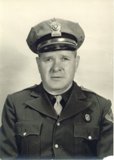
|
Charles Owen Purdin - Captain
Muskogee Police Department September 17, 1957
About 11 a.m. on Wednesday July 31, 1957, Captain Charles Purdin was escorting a funeral procession on his 1956 Harley-Davidson police motorcycle when he accidentally collided with the last car in the procession as it slowed to enter the cemetery. Captain Charles Purdin suffered a compound fractured right leg that was more serious than first thought and the first week of September Captain Purdin’s right leg was amputated. Captain Purdin appeared to rally after the operation but developed a blood clot and died the afternoon of Tuesday, September 17, 1957.
Captain Charles Purdin was survived by his wife Elva and their four children and is buried in Memorial Park Cemetery, Muskogee, Muskogee County, Oklahoma.
OLEM – 7N-4-5 NLEOM – 20W24
Updated September 13, 2023
|
|
|
|
|
|
O "Bud" Pursley - Posseman, Deputy U.S. Marshal
U.S. Marshal Service November 9, 1884
In early November 1884, Deputy U.S. Marshal James Mershon and his posse went in search of Jonas Layson and Salone George, wanted for murder. Deputy Marshal James Mershon had information the two wanted men might be in the area of Tishomingo. Deputy Marshal Mershon set up camp near Tishomingo and his posse went into the field in search of information on the two men. The posse returned with information that Layson and George were living with Jonas Layson’s father near Tishomingo. Because they were dealing with two murder suspects, Deputy Mershon assigned four posse, George Pound, O. “Bud” Pursley, Wit Blankenship, and Bruce McKee to make the arrest.
On the early morning of Monday, November 3rd, the four-member posse rode up to the Layson house and announced their presence and indicating they were federal officers. They ordered the occupants to surrender. Before the posse could take any further action, Jonas Layson fired on the posse with a Winchester rifle. One of the shots struck Posse “Bud” Pursley, 21, in the left arm, totally disabling him. The other officers returned fire as Jonas Layson and Salone George ran from the house. One of the posse members managed to hit Jonas Layson, who feel dead in the bushes. Salone George managed to escape unharmed.
Posse “Bud” Pursley’s wound was extremely serious and turned into gangrene. His arm was amputated but “Bud” Pursley lay in agony for two days before dying on Sunday, November 9, 1884.
O. “Bud” Pursley is buried in Oakwood Cemetery, Denison, Grayson County, Texas.
OLEM – 4N-3-9 NLEOM – 24W2 [Pusley]
Updated November 8, 2024
|
|
|
|
|
|
John N. C. "Pushmataha" Fulsom- City Marshal
Nowata, Cherokee Nation. I.T.
During the mid-1890’s racial prejudice was rampant, and tensions were high in Oklahoma and Indian Territories. The Cherokees appointed a town marshal for Nowata named Pushmataha, also known as John Fulsom, Johnson Fulsom, Johnson Push and Push Johnson. His half-brother, known as William Fulsom and Willie Hickey, acted as his deputy.
The white citizens of Nowata hired their own City Marshal, a renowned gunfighter named George Goodell. No amateur, he had served alongside of men like Wyatt Earp, Bill Tilghman, the Masterson brothers, Ben Thompson and Doc Holliday. George Goodell was also commissioned as a Deputy U.S. Marshal for the Northern District of Indian Territory.
The Fulsoms openly made threats against George Goodell and threatened to ambush him if he ever crossed them. In early November of 1897, George Goodell arrested City Marshal Pushmataha (Johnson Fulsom) for being drunk. Pushmataha’s half-brother William Fulsom and other Indians soon broke him out of jail.
On November 13, George Goodell arrested Willie Hickey (William Fulsom) and, when Hickey tried to escape, George Goodell mortally shot him. The dying man was taken to a local store. When City Marshal Pushmataha (Johnson Fulsom) heard about it, he rushed to the store to confront George Goodell. When Pushmataha arrived at the store, George Goodell shot and killed him also. The white citizens said their City Marshal, George Goodell had killed the two Fulsom men to prevent them from ambushing him and the Cherokees said Goodell had murdered both in cold blood.
George Goodell surrendered, unknowing of the depth of the political morass he was entering. Promising a light sentence, a U.S. Attorney convinced George Goodell to plead guilty to manslaughter. The judge, however, sentenced him to twenty years in prison. A year after the killings, George Goodell went to prison in Columbus, Ohio. After serving three and one-half years of his sentence, George Goodell was pardoned by President Theodore Roosevelt in 1902.
Johnson “Pushmataha” Fulsom was survived by his wife Ora and is buried in an unmarked grave in Nowata Cemetery, Nowata, Nowata County, Oklahoma.
OLEM – 5N-4-13 (C Pushmataha) NLEOM –
Updated December 5, 2024
|
|
|
|
|
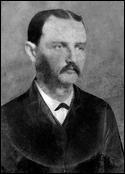
|
Ezekiel McClellan "Zeke" Putnam - City Marshal
City of Allen January 16, 1909
Saturday evening, January 16, 1909, about 8 p.m. while standing in Whitehead and Ashford’s general store at Allen, City Marshal Zeke Putnam, 46, received a full charge of buckshot, fired at him through the store window. City Marshal Zeke Putnam was killed instantly.
Bloodhounds were sent for to track down the suspects, but they didn’t arrive for thirty hours. The bloodhounds were able to follow a trail for a short distance to where two men had mounted horses, but they lost the trail after a short distance.
City Marshal Ezekiel Putnam was survived by his wife Pearl and fifteen-year-old daughter Francis.
Ezekiel Putnam is buried in Rosedale Cemetery, Ada, Pontotoc County, Oklahoma.
The suspect was eventually identified as Dan Scribner. Dan Scribner was arrested, tried, convicted, and sentenced to death but the Court of Criminal Appeals overturned the verdict and ordered a new trial. Dan Scribner’s lawyer was able to get a change of venue to Seminole. On August 22, 1911, Dan Scribner was convicted a second time and sentenced to life imprisonment. In 1923 Dan Scribner’s life sentence was commuted to twenty-two years in prison.
OLEM – 10N-2-12 NLEOM – 19E23
Updated January 8, 2024
|
|
|
|
|
|
William "Bill" Pytchlyn - Officer
Ada Police Department November 27, 1934
William Pitchlynn was born June 14, 1905, in Pauls Valley, Garvin County, Oklahoma, to George and Emma (Curry) Pitchlynn.
William “Bill” Pitchlynn joined the Ada Police Department on October 1, 1934. An Ada businessman had been robbed by two black men and he requested that Bill Pitchlynn receive a “special commission as a colored officer” because he thought he would have a better chance of solving the crime than white officers. A special commission was issued.
Officer William Pitchlynn had been commissioned slightly over a month when he was accosted by two suspects in the robbery, Oliver Jackson and Cruce Moses, in the black area of North Broadway on Sunday evening, November 11, 1934. Both suspects were armed, and the officer attempted to disarm them. In the process, Officer William Pitchlynn was shot in one arm and the chest.
Officer William “Bill” Pitchlynn, 30, died from his wounds on Tuesday, November 27, 1934.
Officer William Pitchlynn is buried in Bethlehem Cemetery, Pauls Valley, Garvin County, Oklahoma.
Oliver Jackson and Cruce Moses were both later arrested and charged with killing Officer William Pitchlynn.
OLEM – 9S-2-11 (Pytchlin) NLEOM – 39W5 [Pytchlyn]
Updated November 20, 2023
|
|
|
|





